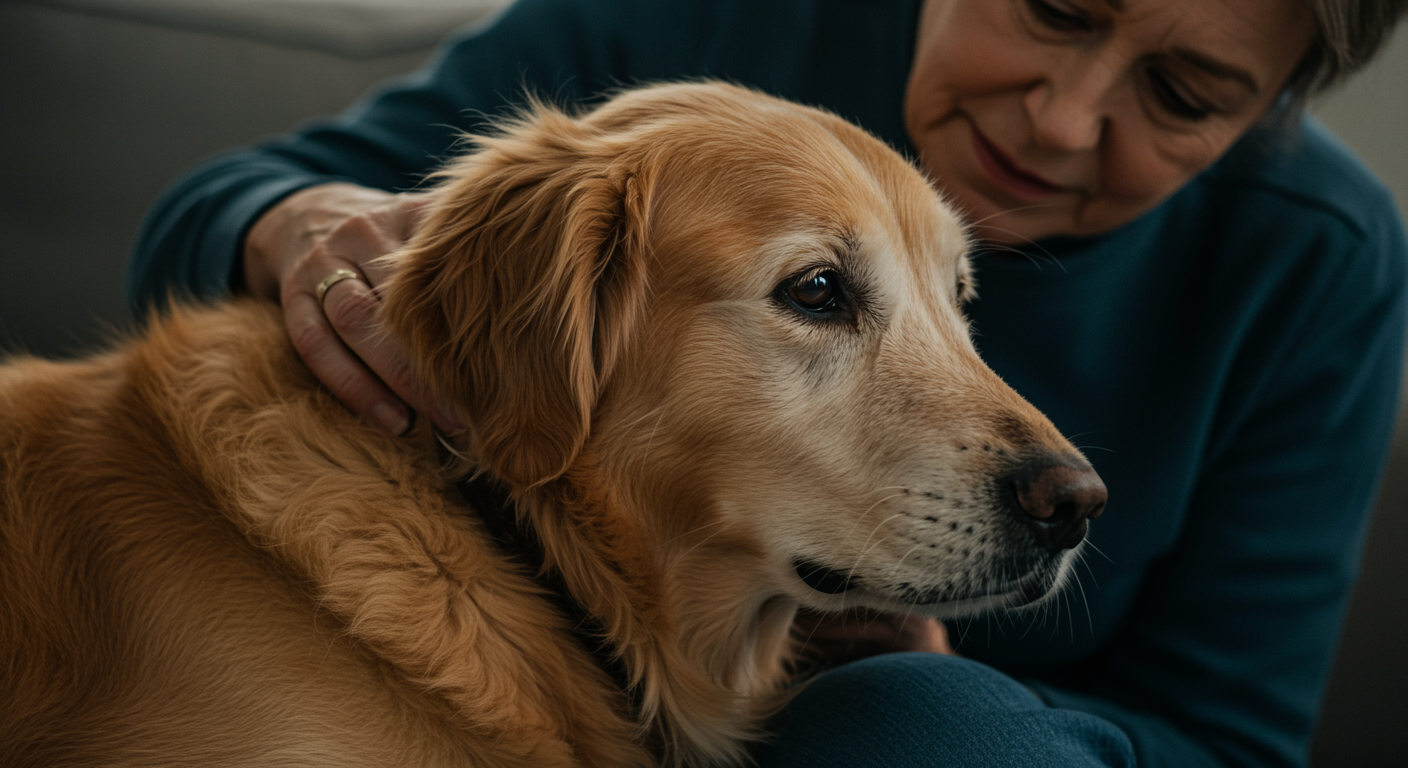Palliative care represents a compassionate approach to managing terminal conditions in senior Golden Retrievers, focusing on comfort, dignity, and quality of life rather than curative treatments. This specialized care philosophy acknowledges that some conditions cannot be cured while emphasizing that much can still be done to ensure peace, comfort, and meaningful time with beloved companions during their final chapter.
Understanding palliative care principles becomes increasingly important as Golden Retrievers age and face terminal diagnoses such as advanced cancer, end-stage organ failure, or progressive neurological conditions. These situations require difficult decisions about treatment goals, comfort measures, and quality of life assessments that benefit from careful planning and professional guidance.
The transition to palliative care doesn’t mean giving up hope or abandoning treatment; rather, it represents a shift in focus toward maintaining the best possible quality of life while managing symptoms and providing emotional support for both the dog and their human family during this challenging time.
Understanding Palliative Care Philosophy
Defining Palliative Care Goals
Comfort-Centered Approach
Palliative care for terminal senior Golden Retrievers prioritizes comfort above all other considerations. This approach focuses on managing pain, reducing distress, and maintaining dignity while allowing the dog to experience as much normalcy and joy as possible during their remaining time.
The comfort-centered philosophy recognizes that aggressive treatments may sometimes cause more distress than benefit, particularly when prognosis is poor. Instead, interventions are chosen based on their ability to improve comfort and quality of life rather than extend life at any cost.
This approach requires careful assessment of each intervention’s potential benefits and burdens, always keeping the dog’s comfort and well-being as the primary consideration in decision-making processes.
Quality Over Quantity
Palliative care emphasizes quality of life over quantity of time, recognizing that a few comfortable, dignified days may be more valuable than weeks of suffering with aggressive treatments. This philosophy helps guide difficult decisions about treatment intensity and intervention choices.
Quality of life assessments become central to palliative care planning, with regular evaluation of the dog’s ability to enjoy basic pleasures such as eating, social interaction, and comfortable rest. These assessments help guide ongoing care decisions.
Understanding that each dog’s definition of quality may be different helps individualize palliative care approaches based on the dog’s personality, preferences, and what has brought them joy throughout their life.
When to Consider Palliative Care
Terminal Diagnosis Indicators
Palliative care becomes appropriate when curative treatments are no longer effective or when the burden of treatment exceeds the potential benefits. Common terminal conditions in senior Golden Retrievers include advanced cancer, end-stage heart failure, kidney failure, or severe neurological decline.
The decision to transition to palliative care often occurs when multiple treatment attempts have failed, when the dog’s condition continues to decline despite aggressive treatment, or when diagnostic tests reveal widespread disease that cannot be effectively treated.
Sometimes the transition occurs gradually as treatment goals shift from cure to comfort, while other times a sudden decline or new diagnosis may prompt immediate consideration of palliative care approaches.
Quality of Life Deterioration
Significant deterioration in quality of life indicators such as mobility, appetite, social interaction, and comfort levels may signal the need for palliative care even when specific terminal diagnoses haven’t been confirmed.
Dogs who no longer enjoy activities that previously brought them pleasure, who struggle with basic functions like eating or elimination, or who show persistent signs of discomfort may benefit from palliative care approaches.
The timing of palliative care initiation should ideally occur before quality of life becomes severely compromised, allowing for proactive comfort measures rather than reactive crisis management.
Comprehensive Comfort Assessment
Physical Comfort Evaluation
Pain Recognition and Management
Pain assessment in terminal senior Golden Retrievers requires careful observation of subtle behavioral changes, as dogs often mask discomfort until it becomes severe. Changes in posture, movement patterns, breathing, and facial expressions can indicate pain levels.
Effective pain management forms the cornerstone of palliative care, utilizing multiple approaches including medications, physical therapy, environmental modifications, and alternative therapies to achieve optimal comfort levels.
Pain management protocols should be individualized based on the underlying condition, the dog’s response to different interventions, and the family’s comfort level with various treatment approaches.
Mobility and Movement Support
Maintaining mobility for as long as possible supports both physical comfort and psychological well-being. Assistive devices such as harnesses, ramps, orthopedic bedding, and mobility aids can help preserve independence and dignity.
Physical therapy techniques adapted for terminal conditions can help maintain muscle strength, joint mobility, and circulation while providing gentle, comforting interaction that many dogs find soothing.
Environmental modifications to reduce barriers and create safe, accessible spaces allow dogs to continue participating in family life while accommodating physical limitations.
Emotional and Psychological Comfort
Maintaining Routine and Normalcy
Preserving familiar routines and activities that the dog enjoys helps maintain psychological comfort and a sense of normalcy during terminal illness. Simple pleasures like favorite sleeping spots, gentle walks, or social interactions can provide significant comfort.
Adapting beloved activities to accommodate physical limitations allows continued participation while respecting the dog’s changing capabilities. Short, gentle versions of favorite activities may be more appropriate than complete elimination.
Maintaining social connections with family members and, when appropriate, other pets helps preserve the emotional bonds that contribute significantly to quality of life and psychological comfort.
Stress Reduction Strategies
Creating calm, peaceful environments helps reduce stress and anxiety that can worsen symptoms and decrease comfort levels. Minimizing disruptions, providing quiet spaces, and maintaining predictable routines support emotional well-being.
Some dogs benefit from anxiety-reducing medications or natural supplements when stress significantly impacts their comfort or quality of life. These interventions should be discussed with veterinary professionals experienced in palliative care.
Understanding and responding to the dog’s communication about their needs and preferences helps reduce frustration and anxiety while supporting their sense of agency and dignity.
Palliative Care Management Strategies
| Care Domain | Assessment Method | Intervention Options | Monitoring Parameters | Family Involvement |
|---|---|---|---|---|
| Pain Management | Behavioral observation, response to touch | Medications, therapy, positioning | Activity level, appetite, sleep quality | Daily comfort assessment |
| Mobility Support | Movement assessment, balance testing | Harnesses, ramps, bedding, assistance | Independence level, fall prevention | Environmental modifications |
| Nutritional Support | Appetite monitoring, weight tracking | Appetite stimulants, hand feeding, IV fluids | Food intake, hydration, weight stability | Meal assistance, food preparation |
| Emotional Comfort | Behavioral changes, social interaction | Routine maintenance, gentle activities | Engagement level, stress indicators | Quality time, familiar activities |
| Symptom Management | Condition-specific assessment | Targeted medications, supportive care | Symptom severity, treatment response | Medication administration, observation |
| Environmental Comfort | Safety assessment, accessibility review | Home modifications, comfort items | Safety incidents, comfort level | Home preparation, supervision |
Medical Management in Palliative Care
Symptom-Specific Interventions
Respiratory Support
Dogs with terminal conditions may develop breathing difficulties requiring specialized management approaches. Oxygen therapy, bronchodilators, or other respiratory support measures can significantly improve comfort when breathing becomes labored.
Positioning strategies such as elevated sleeping areas or specific body positions can help ease breathing difficulties and reduce anxiety associated with respiratory distress.
Environmental modifications including air purification, humidity control, and temperature regulation can support respiratory comfort and reduce stress on compromised breathing systems.
Gastrointestinal Support
Nausea, vomiting, and appetite loss commonly accompany terminal conditions, requiring proactive management to maintain comfort and nutrition. Anti-nausea medications, appetite stimulants, and dietary modifications can help manage these symptoms.
Nutritional support may include hand feeding, syringe feeding, or in some cases, temporary feeding tubes to ensure adequate nutrition when oral intake becomes difficult or impossible.
Addressing constipation or diarrhea through dietary modifications, medications, or supportive care helps maintain dignity and comfort while preventing complications that could worsen overall condition.
Medication Management
Pain Control Protocols
Effective pain management often requires multiple medications working together to address different aspects of pain and discomfort. Opioids, anti-inflammatory drugs, and adjunctive medications may be combined for optimal comfort.
Regular assessment and adjustment of pain medications ensures optimal comfort while minimizing side effects that could impact quality of life. This requires close communication with veterinary professionals experienced in pain management.
Some families may have concerns about pain medication side effects or addiction, requiring education about appropriate use of pain medications in terminal care situations where comfort is the primary goal.
Palliative Medications
Beyond pain control, various medications can address specific symptoms that impact comfort and quality of life. Anti-nausea drugs, appetite stimulants, and anxiety medications may all play roles in comprehensive palliative care.
Medication timing and administration methods should be adapted to the dog’s condition and family capabilities. Some medications may be given as needed rather than on strict schedules when comfort is the primary goal.
Understanding potential medication interactions and contraindications becomes important when multiple drugs are used simultaneously, requiring professional oversight and monitoring.
Home Environment Optimization
Physical Environment Modifications
Safety and Accessibility
Creating safe, accessible environments prevents injuries while allowing the dog to maintain as much independence as possible. Non-slip surfaces, adequate lighting, and removal of obstacles help prevent falls and injuries.
Accessibility modifications such as ramps, steps, or lifts can help dogs continue to access favorite areas while accommodating mobility limitations. These modifications should be introduced gradually to allow adaptation.
Comfortable resting areas with orthopedic support, appropriate temperature control, and easy access to water and food help maintain comfort throughout the day and night.
Comfort Enhancement
Specialized bedding designed for senior or ill dogs can provide pressure relief, temperature regulation, and joint support that significantly improves comfort during extended rest periods.
Air quality improvements through purification systems or simply ensuring good ventilation can help dogs with respiratory compromise breathe more easily and comfortably.
Noise control measures such as soft music, white noise, or simply reducing household noise levels can help create peaceful environments that support rest and recovery.
Family Integration and Involvement
Daily Care Routines
Establishing manageable daily care routines helps ensure consistent comfort while allowing family members to contribute meaningfully to the dog’s care. Simple tasks like gentle grooming, medication administration, or comfort positioning can be shared among family members.
Teaching family members to recognize signs of discomfort or distress ensures prompt intervention when needed while empowering everyone to contribute to the dog’s comfort and well-being.
Creating structured approaches to care helps prevent overwhelming family members while ensuring all necessary comfort measures are consistently provided.
Meaningful Interaction
Encouraging gentle, appropriate interaction helps maintain the emotional bonds that are so important to both dogs and their families during terminal illness. Simple activities like gentle petting, quiet conversation, or just peaceful companionship can provide significant comfort.
Understanding the dog’s changing preferences and energy levels helps guide interaction timing and intensity, ensuring that social contact remains positive and comforting rather than overwhelming or stressful.
Creating opportunities for meaningful moments and memory-making while respecting the dog’s condition and comfort needs helps families process the approaching loss while maintaining connection.
Nutritional Support and Hydration
Appetite Management
Stimulating Food Interest
Loss of appetite commonly accompanies terminal conditions, requiring creative approaches to encourage eating and maintain nutritional status. Warming food, offering variety, or using especially palatable options may help stimulate interest.
Hand feeding can provide both nutritional support and emotional comfort, allowing for close interaction while ensuring adequate intake. Some dogs respond better to being fed by hand than eating independently when they feel unwell.
Small, frequent meals may be better tolerated than larger portions, reducing nausea while providing consistent nutritional support throughout the day.
Alternative Feeding Methods
When oral intake becomes difficult or impossible, alternative feeding methods such as syringe feeding or feeding tubes may be considered based on the dog’s condition and family preferences.
The decision to pursue alternative feeding methods should consider the dog’s overall prognosis, quality of life, and the potential stress or discomfort associated with these interventions.
Some families choose to focus on comfort rather than aggressive nutritional support, offering favorite foods for pleasure rather than attempting to maintain full nutritional intake.
Hydration Management
Maintaining Fluid Balance
Adequate hydration supports comfort and organ function, but approaches to hydration management should be tailored to the individual situation and overall care goals.
Subcutaneous fluid administration can help maintain hydration and improve comfort without the stress of hospitalization or intravenous procedures. This technique can often be performed at home with appropriate training.
The decision about aggressive hydration support should consider the underlying condition, prognosis, and the dog’s comfort with various interventions.
Quality of Life Assessment Tools
Objective Measurement Criteria
Daily Function Evaluation
Regular assessment of basic functions such as eating, drinking, elimination, and mobility helps track changes in quality of life and guide care decisions. Simple scoring systems can help quantify these assessments.
Monitoring sleep quality, pain levels, and interest in surroundings provides information about comfort levels and the effectiveness of current interventions.
Tracking good days versus difficult days helps identify patterns and may guide decisions about treatment adjustments or care planning.
Behavioral Indicators
Changes in social interaction, response to family members, and interest in previously enjoyed activities provide important information about psychological well-being and overall quality of life.
Monitoring stress indicators such as panting, restlessness, or withdrawal helps assess comfort levels and the need for intervention adjustments.
Understanding the individual dog’s personality and normal behaviors helps interpret changes that may indicate declining quality of life or improving comfort.
Family-Centered Assessment
Personal Values Integration
Quality of life assessment should incorporate the family’s values and understanding of what constitutes acceptable quality for their individual dog. What matters most varies among families and dogs.
Regular family discussions about observations, concerns, and goals help ensure that care approaches align with everyone’s values and the dog’s apparent preferences.
Professional guidance can help families navigate difficult quality of life decisions while respecting their values and the dog’s individual needs.
End-of-Life Planning and Decision Making
Advanced Care Planning
Treatment Preference Discussions
Advance planning discussions about treatment preferences, comfort measures, and end-of-life care help families make informed decisions during emotional and stressful times.
Understanding options for end-of-life care, including euthanasia timing and procedures, helps families prepare mentally and emotionally for difficult decisions.
Creating written care plans or advance directives helps ensure that the dog’s comfort and the family’s values are honored even during crisis situations when emotions may interfere with clear decision-making.
Support System Development
Building support networks including veterinary professionals, family members, and potentially pet loss counselors helps families navigate the emotional challenges of terminal care.
Understanding available resources for emotional support, practical assistance, and end-of-life services helps families feel more prepared and supported during difficult times.
Planning for memorial or remembrance activities can help families process grief while honoring their beloved companion’s memory.
Euthanasia Considerations
Timing Decisions
The decision about euthanasia timing represents one of the most difficult aspects of palliative care. Ideally, this decision should be made while the dog still has some quality of life rather than waiting until suffering becomes severe.
Quality of life assessment tools and professional guidance can help families recognize when euthanasia may be the most compassionate option for preventing further suffering.
Understanding that choosing euthanasia can be an act of love and compassion helps families process this difficult decision while focusing on their dog’s comfort and dignity.
Procedure Planning
Planning euthanasia procedures in advance, including location preferences, family participation, and aftercare arrangements, helps ensure that the process aligns with family values and provides comfort for everyone involved.
Many families prefer in-home euthanasia services that allow the dog to remain in familiar, comfortable surroundings while saying goodbye peacefully.
Understanding the euthanasia process helps families prepare emotionally and ensures that their final moments with their beloved companion are as peaceful and meaningful as possible.
Palliative care for terminal senior Golden Retrievers represents a compassionate approach that honors the human-animal bond while prioritizing comfort, dignity, and quality of life during life’s final chapter. Through careful planning, professional guidance, and family involvement, palliative care can help ensure that beloved companions experience their final days with minimal suffering and maximum comfort.
The goal of palliative care is not to extend life at any cost, but rather to make whatever time remains as comfortable and meaningful as possible for both dogs and their families. This approach requires courage, compassion, and commitment, but can provide profound peace in knowing that everything possible has been done to honor the bond and provide comfort during life’s most difficult transition.
Success in palliative care comes from understanding that providing comfort and maintaining dignity are meaningful goals that can bring peace to both dogs and families during terminal illness. Through thoughtful planning and compassionate care, the final chapter can be filled with love, comfort, and peaceful moments that honor the lifetime of joy these beloved companions have provided.

Rafael Souza is a digital marketing strategist and lifelong dog enthusiast. Passionate about Golden Retrievers, he shares practical, research-based tips to help owners provide healthier and happier lives for their furry companions.






1 thought on “Palliative Care for Terminal Senior Golden Retrievers”